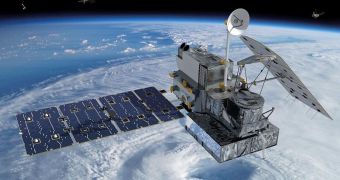The US National Aeronautics and Space Administration (NASA) has a few busy months ahead, which will see it launch a wide variety of missions into low-Earth orbit. Many of these flights will be targeted at the International Space Station, while others are satellite launches aimed at low-Earth orbits. Here is a breakdown of what to expect over the next few months.
The first upcoming launch is scheduled for February 27, and will see the Global Precipitation Measurement (GPM) Core Observatory finally launching into space, from the Tanegashima Space Center, on Tanegashima Island, Japan. This mission will monitor and study rainfall and snowfall patterns across the globe, helping meteorologists refine their weather predictions.
Around two weeks later, Hawthorne, California-based Space Exploration Technologies Corporation (SpaceX) will launch its third commercial resupply services flight to the ISS. The mission will feature the Dragon capsule and the Falcon 9 rocket, which will take off from the Cape Canaveral Air Force Station, in Florida, on March 16. This date is not yet set in stone.
The next significant event is the launch of the Soyuz 38 spacecraft from the Baikonur Cosmodrome, in Kazakhstan, on March 25. The spacecraft will also be heading to the space station, carrying NASA astronaut Steve Swanson, and Russian Federal Space Agency (RosCosmos) cosmonauts Oleg Artemyev and Alexander Skvortsov. Together, the three make up the Expedition 39 crew to the ISS.
About a month later, on April 28, RosCosmos will launch a new resupply mission to the station. This flight will be carried out by the Progress 55 unmanned spacecraft, also launching from Baikonur. This is not a NASA launch, but it does feature a wealth of supplies from the American space agency.
Three days later, on May 1, Dulles, Virginia-based Orbital Sciences Corporation (OSC) will launch its second commercial resupply services flight to the ISS. The mission will be carried out by the unmanned Cygnus capsule, which will launch aboard the OSC Antares rocket from the MARS installation at the Wallops Flight Facility, in Virginia.
Towards the end of the month, Reid Wiseman, Maxim Suraev and Alexander Gerst will launch aboard the Soyuz 39 capsule towards the station, marking the start of Expedition 40 on the ISS. These astronauts will replace the second half of the current Expedition 38 crew on the space lab. The mission will take off on May 28 from Baikonur.
Early the next month, on June 6, SpaceX will conduct its fourth commercial resupply services flight to the station. This time, in addition to all the usual supplies, it will also carry the RapidScat instrument, which will measure ocean surface wind speed and direction and help improve weather forecasts. The flight will take off from the CCAFS, and feature the SpaceX Dragon/Falcon 9 spacecraft combo yet again.

 14 DAY TRIAL //
14 DAY TRIAL //